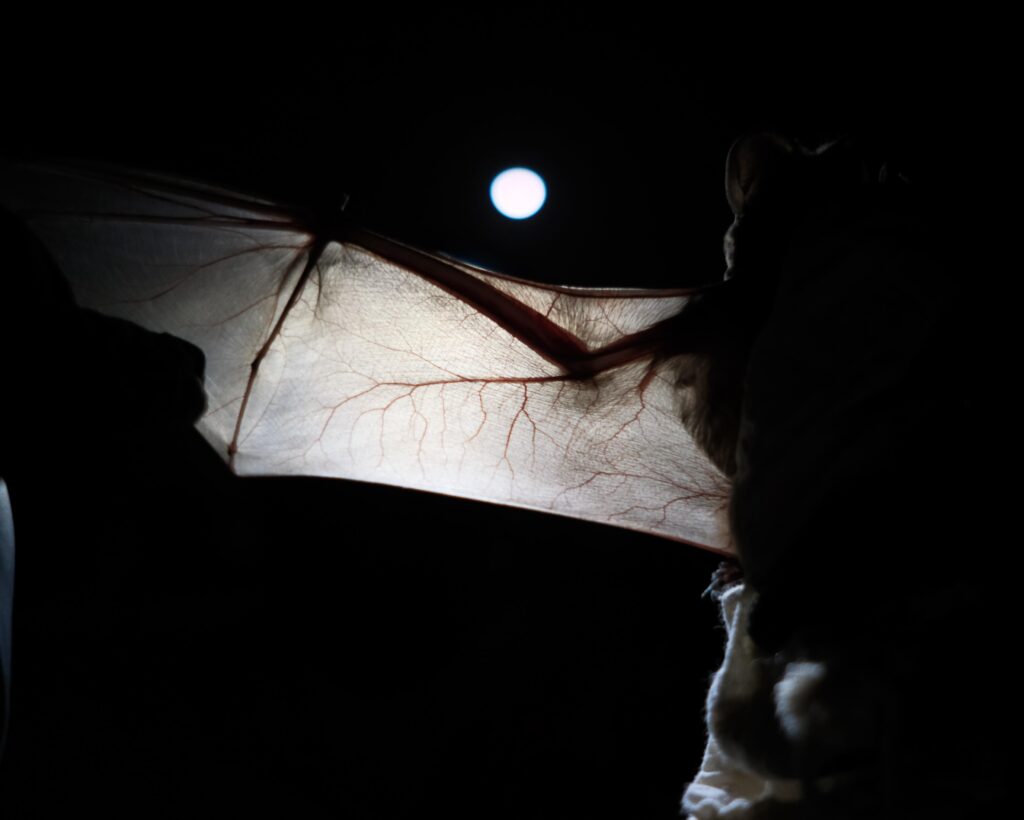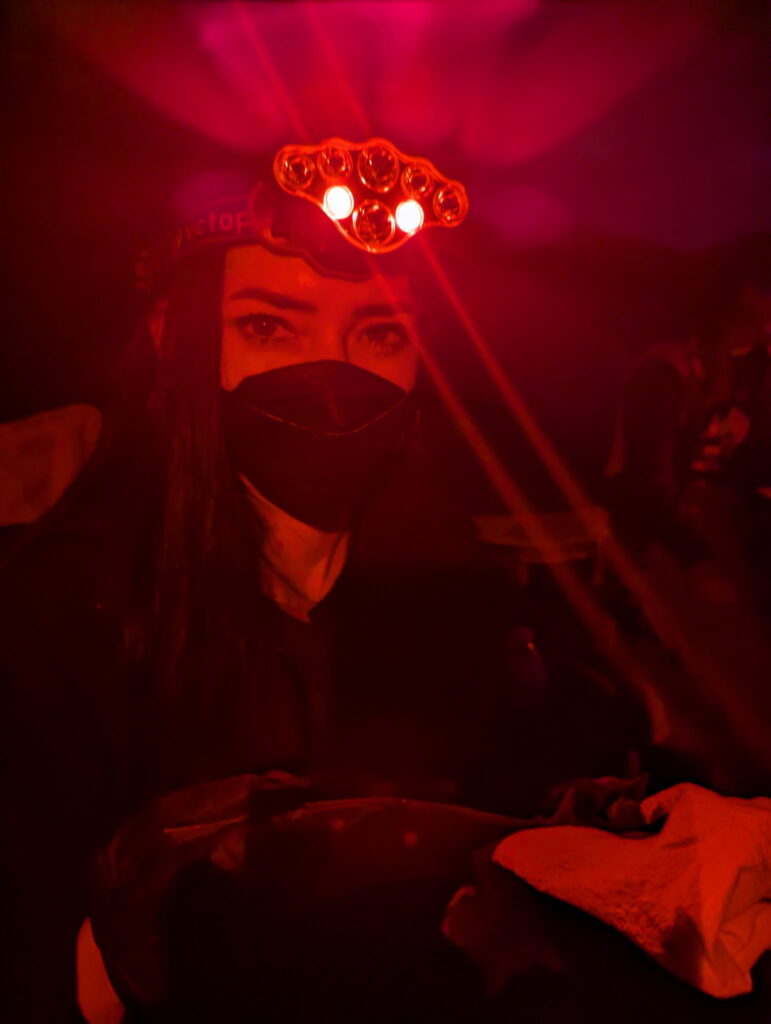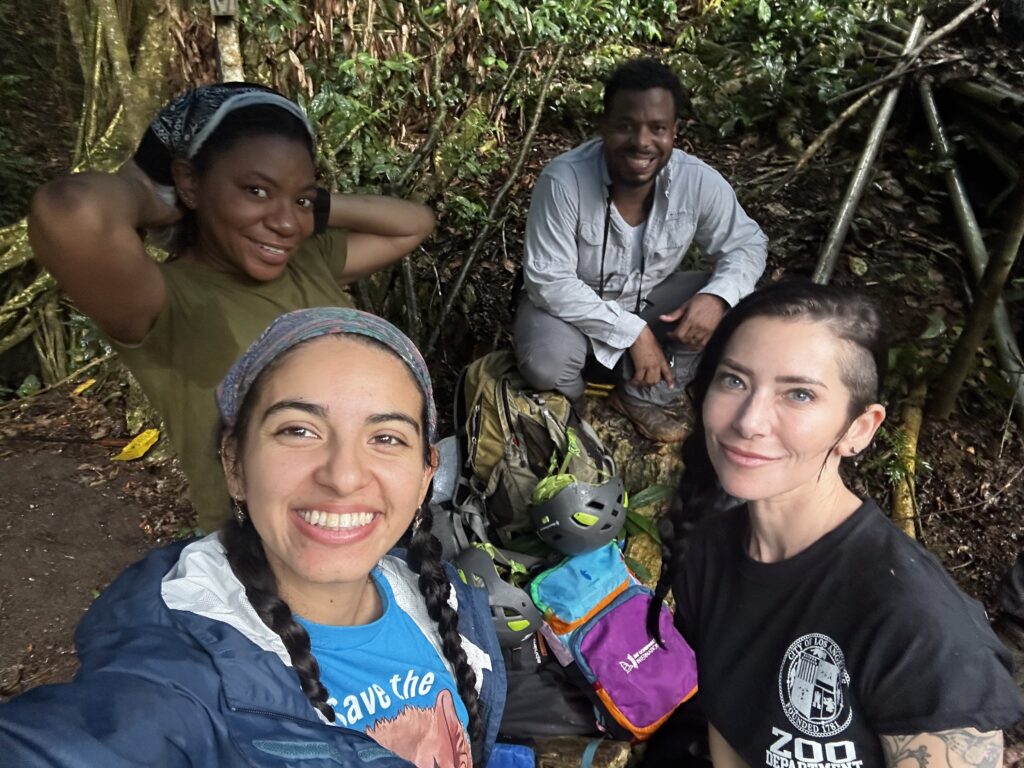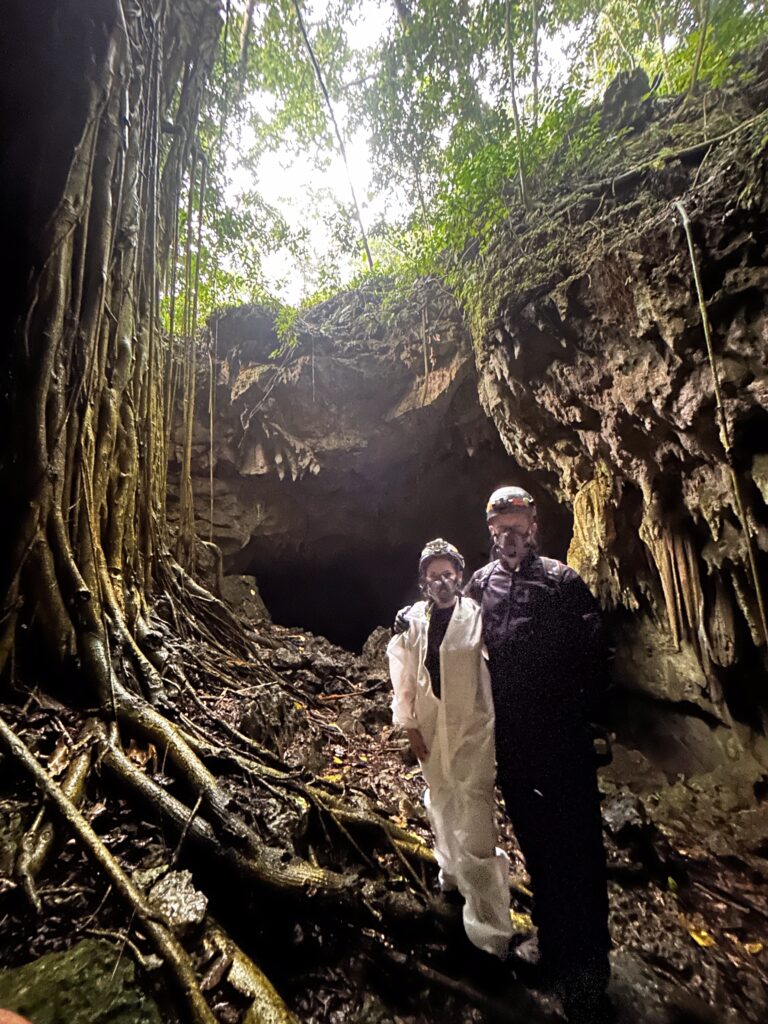
I sit perched on the edge of an examination table with barely contained excitement. A nurse enters with a small syringe in hand, and my smile stretches widely as she wipes my arm with a cool alcohol swab. A rush of anticipation flutters in my chest; today I’m getting the rabies vaccine! It marks the first step toward realizing my 20-year dream of working with bats.
I’ve always loved the underdogs, the misunderstood animals that others find weird, and bats definitely fit that bill. When I was 18, I applied for an internship at an amusement park solely so I could get up close to a trained fruit bat, and since then, I’ve chased the mesmerizing sight of Mexican free-tailed bats in Austin and even dragged my friends up and down Australia in search of giant flying foxes. So when I heard that the Los Angeles Zoo was launching an acoustic bat monitoring program, I jumped at the chance to track the presence of wild bat species throughout the Zoo. After a year of data collection, we confirmed that nine species of bats use Zoo grounds. But as thrilled as I was to learn that bats were here, I wanted to see them up close.
Bats dominate the mammalian world, making up an astonishing 20% of all known mammal species. Their diversity and adaptations make them one of the most successful groups of mammals on the planet. Bats are vital to healthy ecosystems, playing crucial roles in pollination, insect control, and seed dispersal. However, despite their importance, many bat species are under threat due to habitat loss, climate change, and disease, putting their populations—and the ecosystems they support—at risk.

So when the opportunity to apply for the Montgomery Advanced Field Studies Grant came along, I eagerly submitted my application. A month later I got the good news: I would be joining Bat Conservation International (BCI) field projects in Florida and Jamaica—an incredible opportunity to sharpen my field skills, learn directly from some of the world’s leading bat biologists, and, at last, hold these incredible animals in hand.
Straight to Work
I land at Miami International Airport on a humid February evening, just as the clock strikes 7 p.m. Within an hour, I’m en route to Zoo Miami, eager to meet with BCI’s Endangered Species Intervention Regional Director for Latin America and the Caribbean Dr. Melquisedec Gamba-Rios, Director of Conservation Evidence Dr. Teague O’Mara, and Endangered Species Interventions Specialist Stephanie Brinez. My Uber driver pulls up in front of the locked Zoo Miami gate. The surrounding darkness seems endless—no lights, no signs of life, just a deep, swallowing blackness. My driver breaks the eerie silence. “Are you sure this is the right place?” he asks, his voice laced with doubt. “Yes,” I reply, trying to sound confident. As he slowly drives away, a pair of headlights appear at a distance from within the gates. It’s Zoo Miami’s Head of Conservation and Research, Frank Ridgley, pulling up to take me to the field site.

Florida bonneted bats are the nation’s rarest. They are critically restricted to just Central and Southern Florida, where they thrive in the warm climate. Unfortunately, the species has seen a dramatic decline due to habitat loss, climate change, and urbanization. Their preferred habitat, mature pine forests, has dwindled, and the red-cockaded woodpecker—whose nesting holes the bats traditionally used—has vanished. As a result, these bats have adapted to roosting in human-made structures, which has led to human-wildlife conflicts. When Zoo Miami found evidence of Florida bonneted bats on zoo grounds, they partnered with BCI to install artificial roosts, and the bats quickly took to using them. The most important thing we can do for them now is protect the remaining undeveloped land that they fly and feed on.
And that’s why this group of biologists has gathered here tonight under the stars beside an artificial roost. BCI researchers are using lightweight GPS collars to track the bats’ movements. Thirty-foot mist nets stretch skyward around a bat box, and by the time I arrive, the operation is in full swing. Several bats have already been caught, each gently twitching in its own cloth bag. Teague is securing a GPS collar around the neck of one bat while Stephanie gently restrains it. Under the glow of our headlamps, the bat looks like a patchwork of fine brown fur and delicate skin, broken now and then by the glint of tiny, razor-sharp teeth.
Once examined, each bat is returned to its bag to await release after the nets come down. By 11 p.m., the team has tagged six bats. We take down the towering poles and I’m in bed just after midnight—grimy, exhausted, and quietly thrilled.

The Hard Part
For the next three evenings, the routine settles into a rhythm: we set up the mist nets, wait patiently for the bats to emerge, then break everything down. At first, I’m all thumbs. Mist nets are long and delicate, prone to tangles and catching debris. Knot-tying becomes an essential skill, and I’m grateful for the muscle memory from my days tying falconer’s knots at the L.A. Zoo’s World of Birds show. The team is kind and good-humored, whispering jokes in the dark while we wait for our winged guests. Some of the bats have clearly caught on and stubbornly refuse to leave their roosts when they spot the nets. Even so, we manage to successfully tag 31 bats.
Now comes the hard part. We must try to recapture those same tagged bats. The GPS units record location data every minute from 5 p.m. until sunrise. In addition, built-in accelerometers run continuously, capturing flight speed, wingbeat frequency, insect-chasing behavior, and energy expenditure. The results of this research can help inform future habitat management strategies.

Luck is on our side, and we manage to recapture 20 GPS tags. On our final night, we also get to celebrate Melquisadec’s birthday, complete with cake, party hats, and a shared sense of accomplishment. The atmosphere is festive, but there’s a bittersweet undertone—this is likely the last time any of these biologists will hold a Florida bonneted bat in hand. The next morning, we board our flights home, tired but happy.
Three Weeks Later
I’m on a flight to Jamaica, thrilled to learn I’ll be working again with Stephanie, along with Dr. Jon Flanders, Director of Extinction Intervention at BCI. This trip will center on protecting the last remaining cave roosts of two rare and vulnerable species: the Jamaican flower bat and the Jamaican greater funnel-eared bat. Both are in a precarious situation, each restricted to a single cave that is increasingly threatened by human disturbance and predation by domestic cats.
My first impressions of Jamaica are shaped by the people—warm, welcoming, and full of energy. But Kingston is no sleepy beach town. It’s vibrant and chaotic, buzzing with noise, heat, and motion—quite a surprise if you’re expecting laid-back island vibes. After dropping our luggage at the hotel, we head straight to the National Environment and Planning Agency (NEPA) to meet Sherene May-Francis. Sherene is the appointed Bat Project Officer, a government role currently funded by BCI to support bat conservation efforts. She unlocks a cabinet and hands us several large backpacks and boxes packed with field supplies—gear we’ll soon put to good use as we prepare to explore the bat-filled caves of Stony Hill and St. Clair.

A Bat Cave
The next morning, we stop by the Institute of Jamaica to brainstorm ideas for a future bat exhibit at their museum, then set off on the long, bumpy drive to Stony Hill Cave. Tucked within a residential area, the cave is home to 2,000 bats, including the critically endangered Jamaican flower bat, whose fragile ecosystem faces constant threats, like domestic cats. A camera trap installed by BCI captured disturbing footage of cats preying on bats, with 37 killed in just 28 days. In response, BCI purchased the small parcel of land surrounding the cave’s entrance and is now working to install predator-proof fencing to help safeguard the bats.
We take turns entering the cave to minimize disturbance. Inside, we switch our headlamps to red light and rely on a night-vision camera to take in the surreal sight of thousands of bats clinging to the cave ceiling. The air is thick and stifling, easily 15 degrees hotter than outside. These intense, humid conditions are exactly what the Jamaican flower bat needs to breed and survive, but they also make the bats especially vulnerable. Illegal guano mining threatens this delicate balance, introducing light, noise, and disruption that can scare the photophobic bats and alter the cave’s unique microclimate.
Back outside, we stay to watch the bats emerge, with NEPA biologist Damany Calder sharing fascinating local natural history as we wait for the sun to set. The fast-flitting, mustached bats dart out first, followed 30 minutes later by the relatively large, pale Jamaican flower bats that swirl beneath the tree canopy, carefully avoiding the moonlight. The flower bats are ethereal and mesmerizing. Once thought extinct, a mere 250 remain on this planet, and we are viewing those sole survivors. This is my first experience in a cave, but it’s nothing compared to what awaits us next.
Mud and More Mud
I find myself hiking up and down through treacherous terrain with a motley crew of biologists, community members, landowners, and hikers. Some stride confidently in sandals, while I awkwardly stumble in my brand-new hiking boots. We scramble up hills using tree roots as handholds, then slide down slick inclines as we make our way to St. Clair Cave—a sprawling, two-mile-long cavern buried 100 feet underground. It’s home to two million bats, including the incredibly rare Jamaican greater funnel-eared bat, a species so elusive it’s never been photographed.
We reach the cave’s mouth just as the skies open in a torrential downpour. But my excitement doesn’t falter. We shimmy down the dangling roots of a fig tree to reach the entrance, then suit up: Tyvek suits, gloves, respirators, helmets, and headlamps. I’m handed two left-handed gloves and a suit that’s comically oversized.
Perfect. Just the kind of absurd chaos I thrive in.

At the entrance to the cave, the ground is sandy and scattered with strange clusters of spiky, white fungus. I’m later told that this is actually cat feces covered in mold. Just like at Stony Hill, cats are abundant, waiting for an easy meal. As we venture deeper into the cave, the only light comes from our headlamps. Cockroaches scurry away from us at every step, and the ground is littered with wispy finger bones from bats, the grim evidence of past cat hunts. The cave is vast in places, with awe-inspiring stalactites adorning the ceilings, then it quickly narrows, forcing us to clamber down slippery rocks, hoping not to fall. The sandy floor eventually gives way to thick mud, and then to a clear stream.
My giant Tyvek suit rips and drags beneath my boots, accumulating more mud with every step. Then, the worst happens: my headlamp starts to fade. I can’t even see my hands in front of my face. I alert Jon and am forced to follow his footsteps, trying to avoid rocks. We push on, but the bats turn out to be deeper in the cave than expected, so we return to the cave’s mouth to witness the awe-inspiring emergence of millions of bats.
You can hear them before you see them—they chirp and squeak like songbirds. And when a biologist shines a powerful flashlight into the entrance of the cave, I’m stunned by bats swarming in such dense clusters that they blur together, a roiling mass of wings and shadows against the cave walls.
The hike back feels far more grueling now. The path, slick with hours of rain, has turned into a treacherous obstacle course of mud and slippery rocks. The darkness amplifies the challenge, and the quiet of the forest is only broken by our laughter and occasional exclamations as we fumble our way back toward the village. Finally, we reward ourselves with a hearty meal of coconut rice and jerk chicken, capping off the night with a cold Red Stripe beer. Reggae music pulses from booming speakers, and a few feral dogs linger nearby, their eyes hopeful and hungry.
More than Memories
On the long flight back to California, I find myself reflecting on how deeply interconnected everything is. The challenges facing bats in both Florida and Jamaica all trace back to a common root: human activities. But what strikes me most is the power of collaboration. During my time with BCI, the emphasis was always on working together—expert biologists, local stakeholders, and community members—toward solutions that allow both people and wildlife to thrive. BCI’s approach is about more than saving bats, it’s about creating sustainable, mutually beneficial relationships between conservationists and communities. In the end, it’s that spirit of cooperation that will drive real, lasting change.
Back at the Los Angeles Zoo, I’m carrying with me more than memories. In my role as coordinator of conservation engagement, I’m eager to apply what I’ve learned as we expand and refine our bat programs here at home. And perhaps most importantly, I’m returning with a larger network—a global community of passionate conservationists I can lean on, learn from, and collaborate with as we work together to protect bats and the ecosystems we all share.

